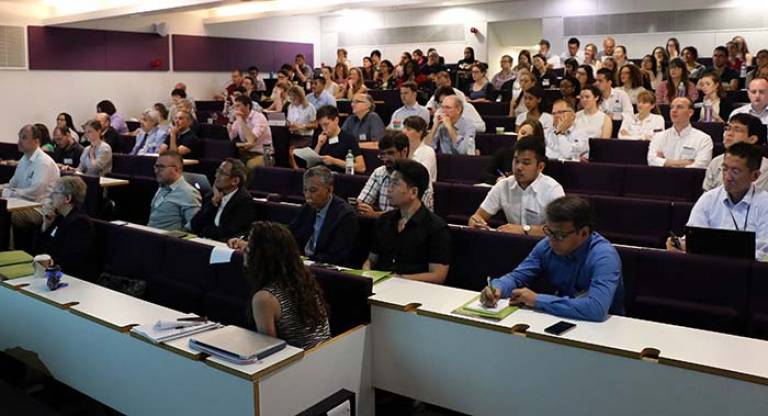IRDR 7th Annual Conference Report
13 July 2017
Our 7th Annual conference was held on 21st June 2017 and attended by over 150 people.
 Our audience, speakers, and presenters came from a range of different backgrounds, and all gathered together to share and discuss research, approaches and initiatives to work towards the aim of reducing global disaster risk. It was a great opportunity for academics, practitioners, students, policy makers and the interested public to share ideas, discuss current challenges and new ideas, and to network.
Our audience, speakers, and presenters came from a range of different backgrounds, and all gathered together to share and discuss research, approaches and initiatives to work towards the aim of reducing global disaster risk. It was a great opportunity for academics, practitioners, students, policy makers and the interested public to share ideas, discuss current challenges and new ideas, and to network. Below, we summarise each of the conference sessions, with audio recordings and slides also included for some sections.
Session Summaries
Safer Communities through Safer Schools and Digital Health
Summarised by Rebekah Yore
The Safer Communities through Safer Schools and Digital Health talks opened the UCL IRDR 7th Annual Conference. This session was chaired by Dr Carmine Galasso from the UCL department of Civil, Environmental & Geomatic Engineering (CEGE) and the Institute for Risk and Disaster Reduction (IRDR), and Dr Patty Kostkova of the UCL IRDR. The safer schools section featured Professor Dina D'Ayala (UCL CEGE), Professor Lessandro Garciano (DLSU), Dr Winston Oreta (DLSU) and Dr Christophe Belperron (Save the Children) as speakers.
Professor D'Ayala opened with an overview of the global imperative to strengthen school infrastructure in countries vulnerable to the destructive forces of natural hazards. She demonstrated how international agreements such as the Global Platform for Disaster Risk Reduction and the Comprehensive School Safety Framework have enshrined the need to work pro-actively in supporting and maintaining effective risk management and resilience-building at all levels, rather than reactively. She showcased her current work through the Global Program for Safer Schools (GPSS), a collaborative project with the World Bank that aims to establish a baseline of requirements for defining school "safety" on a global level. An integral element of the ongoing work is therefore attempting to standardise the classifications used for the varying school structures, and establishing universal definitions, parameters and taxonomies for engineers and communities that can enable to uniform regulation of building risk assessments, building codes and standards, and building design.
We were then introduced to the Safer Communities through Safer Schools (SCOSSO) project, which is a part of the Philippines Resilience of School Infrastructure to Multi Hazard (PRISMH) collaboration between the UCL EPICentre, De La Salle University (DLSU) in Manila and Xavier University in Cagayan de Oro, Philippines. The project's focus on the Philippines means that the safety of school buildings, as critical infrastructure in the face of natural hazards, is of paramount importance given their dual purpose: acting as both educational facilities and emergency evacuation shelters in hazardous conditions. Leading the research in the Philippines, Professor Garciano and Dr Oreta's ongoing work focuses on the creation of a safety assessment tool based on the Evacuation Safety Index (ESI) for public schools across the Philippines. This aims to quantify the safety of each school in terms of both its disaster preparedness and its disaster response capabilities, based on the usability of the rooms within for shelter, and the capacity for continuing with its educational function following a crisis.
Dr Christophe Belperron ended the first half of the session with an overview of the purpose and role of the Comprehensive School Safety Framework (CSSF), established through the Global Alliance for Disaster Risk Reduction and resilience in the Education Sector (GADRRRES). The Framework aims to mainstream Disaster Risk Reduction (DRR) and encourage a sustained culture of resilience among staff and students. It also encourages a holistic view of child protection in the face of risk, recognising that the safety of environments around schools is as important as the safety of the schools themselves in protecting communities, and that small but more frequent shocks can be just as damaging to vulnerable populations as the large disasters that attract the world's focus. A number of "do-it-yourself" toolkits have been created for school-based self-assessment, and numerous online resources are available to the public.
The second part of the session focussed on the use of games and digital technology for disseminating health and hygiene education and awareness. Opening the presentations herself, co-chair Dr Patty Kostkova (UCL IRDR) introduced two ongoing digital health projects. The first comprises a game-based learning programme, using crowdsourced data via community participatory surveillance and aims at issuing health advice around the spread and contraction of the Zika virus in Brazil. The second project, MANTRA (Maternal and Newborn Technology for Resilience in rural Areas) also utilises mobile technology for public health interventions, and works to increase maternal and child health resilience before, during and after disasters in Nepal. The project aims to more thoroughly understand and characterise risk, culture and knowledge in largely rural and remote areas, as well as to enhance access to information and communications through local voices, images and local Female Community Health Volunteers (FCHVs).
Dr Andreea Molnar (Lancaster University) closed the session with a summary of the "Edu Games 4 All" initiative, which is developing a platform for child-centred educational games and storytelling techniques based around the importance of hygiene and sanitation. Born out of a concern over the rise in antimicrobial resistance, it aims to target schools as centres of education and children as effective agents of change in their communities, to encourage the more widespread adoption of healthy hygiene practices and lessen the global reliance on antibiotics.
The multidisciplinary panel provided a wide-ranging and fascinating array of approaches to technical and community-based disaster risk management, encompassing expertise from the worlds of engineering, technology, the social sciences, and health.
The Grenfell Tower Disaster
With the IRDR annual conference taking place just one week after the Grenfell Tower fire, this recent, local disaster was very much at the forefront of our minds. UCL IRDR's Professor David Alexander has conducted research into high rise building disasters previously, and teaches on the topic at UCL. A special segment in the conference was made therefore, for his commentary and observations around the recent Grenfell tragedy. See below for his full presentation delivered at the IRDR annual conference on high rise tower disasters and the Grenfell Tower fire.
If the above embedded audio and slideshow does not work, please try:
Disaster Law, Rights and Altruism
Summarised by Rebekah Yore
The Disaster Law, Rights and Altruism discussions was organised by Dr Ilan Kelman (UCL IRDR and the Institute for Global Health, IGH), and chaired by Professor David Alexander (UCL IRDR). Panellists included Dr Karen da Costa (UCL Laws), Marie Aronsson-Storrier (University of Reading) and Dr Benjamin Abo (University of Florida).
The session began with a comprehensive presentation by Dr da Costa on the Sendai Framework for Disaster Risk Reduction 2015-2030, the first major agreement of the post-2015 development agenda, with seven targets and four priorities for action. Endorsed by the UN General Assembly following the Third UN World Conference on Disaster Risk Reduction (WCDRR) in 2015, this non-binding agreement aims to markedly reduce disaster-related risk and life loss, and lays the foundations for protecting livelihoods, health, economic, physical, social, cultural and environmental assets, businesses, communities and countries. Dr da Costa segmented and deconstructed a number of key elements of the Framework, detailing its drive to both integrate and elevate the role of civil society as well as key stakeholders including the private sector, in global resilience building, while maintaining the responsibilities and accountabilities of nation state-level, critical decision makers. She highlighted its approach as an "action oriented" plan, with cooperative and inclusive language.
Marie Aronsson-Storrier then introduced us to the developing field of International Disaster Law, and the application of Human Rights Law to the world of disaster risk reduction. Framing the evolution of how human rights have become increasingly recognised as integral to the legal protection of vulnerable groups in hazards and crises, she drew on the landmark case study of Budayeva and others v. Russia (2008). The case concerned the events of 18-25 July 2000, when a mudslide led to a catastrophe in the Russian town Tyrnauz, threatening the lives of its inhabitants and resulting in eight deaths. The European Court of Human Rights found that the authorities neglected to implement land-planning and emergency relief policies despite Tyrnauz being particularly vulnerable for mudslides. The Court also determined that the lack of any state investigation or examination of the accident also constituted a violation of the European Convention on Human Rights (ECHR). It concluded that the Russian Government had failed to fulfil its obligations under Article 2 of the ECHR to protect the right to life of people under its jurisdiction. In light of the recent Grenfell Tower fire in London, parallels regarding the rights to life, property, safety and security, and freedom from discrimination were also drawn, with a brief discussion on human rights within a UK context.
The session concluded with an inspirational exploration of how theory and ideas make it into practice, and translate into real life. Dr Benjamin Abo charted his journey through working in emergency medicine and as a disaster physician, explaining how he came to establish a US non-profit organisation supporting innovative and culturally relevant methods of providing accessible healthcare, especially to new and expectant mothers, in rural Ethiopia. He espoused the importance of acknowledging how ideas and solutions to social, economic and structural challenges cannot be uniformly transplanted from one context to another, but must account for the cultures and idiosyncrasies of each population and environment. In following his passion for wilderness medicine and the provision of healthcare to remote communities, he encouraged all to remember the "whys?" in what we strive to achieve, and then to take on the "why nots?" if we have ideas that can potentially change the world for the better.
Keynote Address: Emergency Medical Responses in Conflict Areas
Summarised by Sarah Schubert
The keynote speech was given by André Heller Pérache, Head of Programmes for Médecins Sans Frontières (MSF) UK. Of the countries in which MSF are currently working, 55% suffer from conflict or instability.
In this powerful presentation, André discussed power, politics and access, questioning whether we are reaching the most vulnerable and whether we are facing the same obstacles today.
Speaking on sector shifts, André highlighted changing considerations and perspectives on what constitutes a crisis and on the purpose of aid, noting that the humanitarian nexus seeks to bridge the gap between response and recovery. He also spoke about the increase in response to humanitarian needs around conflict in recent years rather than in response to the impact of natural hazards. He cited how aid had become increasingly politically motivated particularly around health security and refugee migration.
The emergency medical response in conflict areas is changing and evolving. Less classical conflict scenarios are now encountered, so different norms and standards for aid workers have developed. Examples were given where aid, including medical assistance, has been criminalised by legal frameworks and increased challenges in search and rescue due to Maritime Law.
Using the fragile state of Yemen as an example, André highlighted the vastly different humanitarian needs of the Yemeni people, ranging from dealing with the devastating cholera epidemic following the breakdown of the municipal services, to the Public Private Partnership (PPP) provision for chronic health conditions, such as kidney dialysis, which had broken down as a result of conflict and the vital importance of restoring the service for patients.
Priorities going forward for MSF are to increase the size and capacity of response, specifically tailored to situations and balancing effectiveness and efficiency.
If the above embedded audio and slideshow does not work, please try:
In Conversation: Gender Responsive Disaster Risk Reduction - Rhetoric or Action?
Summarised by Sarah Schubert
Maureen Fordham, Professor of Gender and Disaster Resilience, was interviewed by Dr Ilan Kelman about how she came to work in this area, why it is important and what the future challenges are.
While undertaking her undergraduate degree in Philosophy and Social Science, Professor Maureen Fordham noted that class and levels of poverty were the only disaggregated data available. She identified that because gender was not disaggregated, the victim group for natural hazards was a 'universal male'. This and the fact that the field was largely male dominated, particularly with ex-military staff, meant that a narrow focus on the problem developed with resulting simplistic solutions. These solutions did not take account of the different ways that varying genders respond to natural hazards, which in some parts of the world can be starkly different. Differential impacts can therefore be felt and Professor Fordham noted the 1991 Bangladesh cyclone as an example. She also noted however that because of a lack of evidence gathered relating to gender it was difficult to provide other examples.
Professor Fordham explained that gender dynamics are not binary but on a female male continuum and as such require different solutions. She was one of the three founding members, all of whom had a background in sociology, who set up and grew the Gender and Disaster Network. Its purpose was to enable like-minded academics to connect with them and with others and gather relevant gender-related resources in one place. By doing this, the goal was to make gender more visible through aspects of vulnerability and active marginalisation in disasters, and in society more broadly, so that equity, rather than equality can be achieved.
Professor Fordham was clear: Better, robust statistics can influence policy. However, one of the biggest challenges is data collection without making individuals more vulnerable, for example, LGBT youth mapping in the Philippines. Whilst useful for research this mapping could potentially make this group targets of crime and violence as a direct result.
Since the Gender and Disasters Network has been established, conceptual change has been achieved; the gender aspect no longer requires explanation of why it forms such an important part of resilience building. This was particularly successful in their contribution to the UN Sendai Framework for Disaster Risk Reduction. Professor Fordham believes that the challenge is now in the 'how'. This is closely linked to the need for empirical evidence, while not being overwhelmed by the complexity or heightening risk for individuals participating to "do no harm".
If the above embedded audio does not work, please try:
Posters: Global Challenges and Advances in Disaster Risk Reduction
The poster session covered a wide range of issues, themes and approaches to disaster risk reduction. Many of the presenters were young scientists from UCL and other London universities showing initial results of promising new research.

Photographs by Dr Ilan Kelman, UCL IRDR and UCL IGH
 Close
Close






